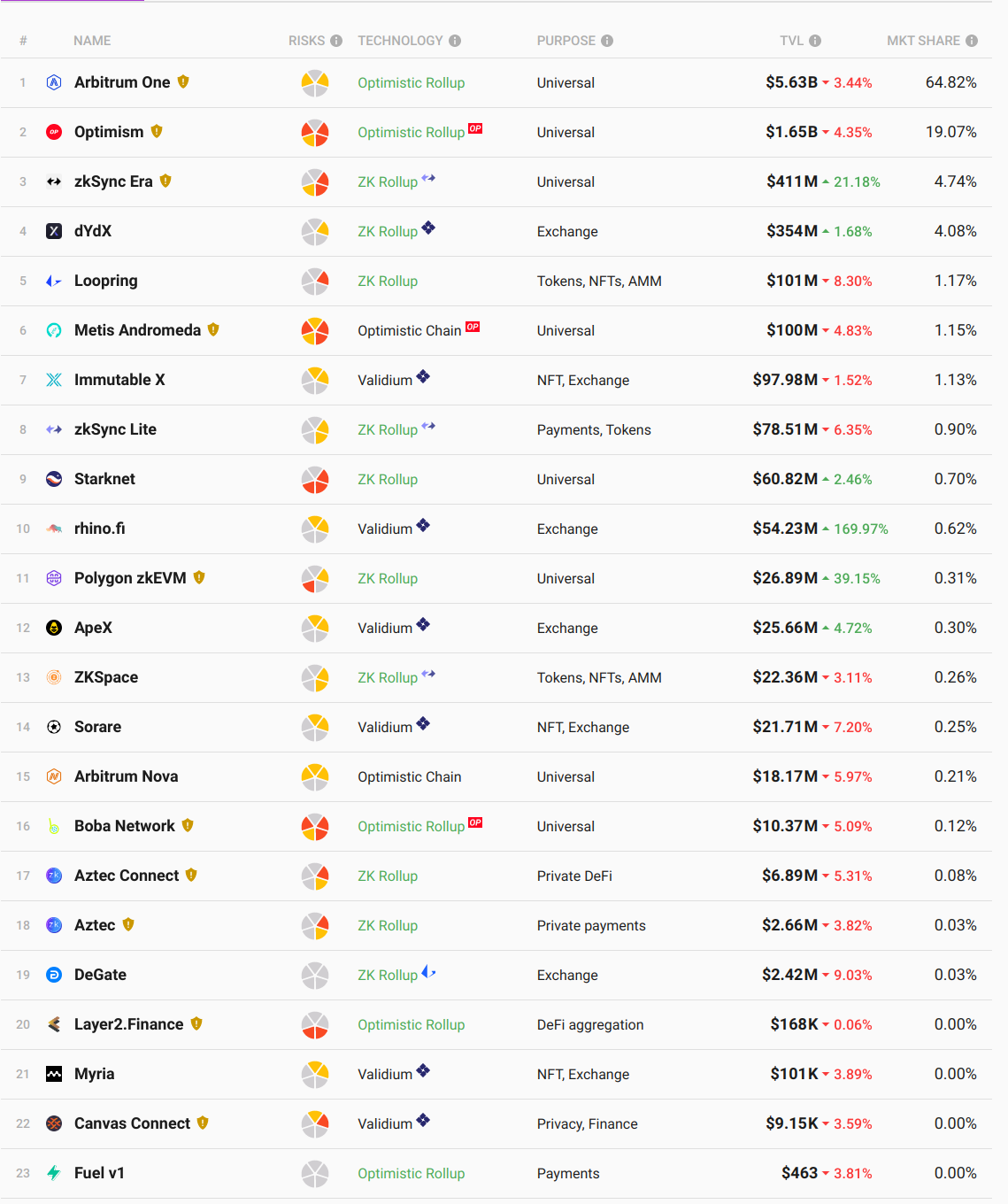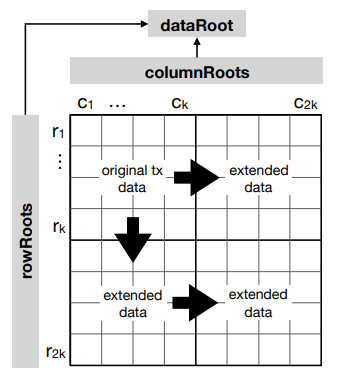Blockchain Scaling - Modular and Heterogeneous
How to use the slides - Full screen (new tab)
Blockchain Scaling
Modular and Heterogeneous
Modularity: decoupling roles of an L1
- Sequencing: ordering operations as input to STF
- Necessary, but always off-chain
- Ordering state transitions
- Definition of a blockchain
- In the case of L2s: commitments to state transitions (usually state roots) of other chains stored on L1 chain
- Executing state transitions
- By definition L2s move execution off-chain
- Data Availability
- Decoupling DA from ordering is often referred to as "modular blockchains" (Celestia)
Taxonomy of L2s

Notes:
Taxonomy of L2s
- Sidechains
- Inherit ordering from L1
- Honest majority bridge (e.g. 5-of-8 multisig)
Taxonomy of L2s
- Smart Contract Rollups
- Inherit ordering and availability from L1
- "Trust-minimized" bridge:
- STF correctness with validity or fraud proofs
- Inbox: option for transactions proposed through base layer to avoid sequencer/proposer censorship
Taxonomy of L2s
- Validiums
- Inherit ordering from L1
- Trust-minimized bridge
- Off-chain DA
Notes:
https://www.starknet.io/en/posts/developers/rollup-validium-volition-where-is-your-data-stored
Taxonomy of L2s
- Sovereign Rollups
- Inherit ordering and availability from L1 (even Bitcoin lol)
- No trust-minimized bridge: correctness and censorship-resistance entirely off-chain
Notes:
- https://celestia.org/learn/sovereign-rollups/an-introduction/
- https://rollkit.dev/blog/sovereign-rollups-on-bitcoin-with-rollkit
Settlement?
- Many in the Ethereum community define rollups by their bridges
- Makes sense if the purpose is scaling ETH transactions
- Rollup nodes can fork the rollup and point at different bridge
- L1 native tokens remain locked
- L2 native tokens retain value
- Some modular consensus layers don't allow settlement: Polkadot and Celestia
Notes:
Data Availability
Data Availability
- Not data storage. Only for a limited time.
- Two purposes:
- Security: to verify STF correctness in optimistic systems (one week in ORUs, ~30s in Polkadot)
- Liveness: for sequencers to download in order to build on top of. Must be a bit longer than STF correctness (~1 day in Polkadot, 30 days in danksharding)
- Cannot use fraud proofs (fisherman's dilemma)
- Simplest option is to post on L1 (Ethereum calldata)
Data Availability Committee (DAC)
- Nodes each redundantly hold data
- Can be off-chain or using committees of L1 validators
- Post threshold signature to L1 attesting to availability
- Coordination can be expensive for rollup users: which shard has my data?
Data Availability Sampling (DAS)
- Data is erasure encoded
- Light clients can verify availability by randomly sampling nodes
- e.g. Celestia (standalone DA layer), Danksharding (Ethereum roadmap), Polygon Avail (built on Substrate), ZKPorter, Eigenlayer
Notes:
- https://arxiv.org/abs/1809.09044
- https://github.com/availproject/data-availability/blob/master/reference%20document/Data%20Availability%20-%20Reference%20Document.pdf
How to ensure coding was done correctly?
- SNARKs: too expensive
- Fraud proofs: requires 2D encoding to be efficient
- KZG commitments: also allows distributed reconstruction (chunking)
2D Reed Solomon

- Computes Merkle roots for rows and columns
- Requires storing 2$\sqrt{n}$ state roots instead of one
- Allows O($\sqrt{n}$) fraud proofs of encoding
DA in Celestia
- Full nodes each redundantly hold erasure coded data off-chain
- Light clients sample 50% and participate in consensus
- Possible incentive problem: easier to scale data than execution so standalone DA layers can more easily be undercut
Notes:
DA in Danksharding
- 2D erasure coded using KZG polynomial commitments
- Also provide proof of encoding
- KZG requires trusted setup, ceremony done earlier this year
- Distributed construction: no nodes need build all rows and columns
- Distributed reconstruction:
- Chunking and sharding similar to Polkadot
- Higher threshold due to 2D encoding
- Allows light client consensus through sampling
- Data removed after 30 days
Notes:
- https://notes.ethereum.org/@vbuterin/proto_danksharding_faq
- https://dankradfeist.de/ethereum/2020/06/16/kate-polynomial-commitments.html
- https://www.youtube.com/watch?v=4L30t_6JBAg
Rollup Security
Validity Proofs for Scaling
- Recursive proofs for constant space blockchains (Mina)
- zk-rollups
- Transactional (private or public): e.g. Aztec
- Application-specific: e.g. STARKDex, Loopring
- Smart contract: e.g. ZEXE (Aleo), zkEVM (Polygon, ZKSync, Scroll)
Notes:
- https://medium.com/hackernoon/scaling-tezo-8de241dd91bd
- https://eprint.iacr.org/2020/352.pdf
- https://github.com/barryWhiteHat/roll_up
- https://zkhack.dev/whiteboard/
Optimistic Rollups: Fraud Proofs
“Don’t go to court to cash a check — just go if the check bounces.”
- Proposers post a state root to L1 with deposit
- Challengers can submit fraud proofs within period (typically 7 days)
- If successful, rewarded portion of deposit
- Fraud proofs can be interactive (Arbitrum) or non-interactive (Optimism)
Notes:
Rollup Training Wheels
- Stage 0
- On-chain DA
- Must have inbox
- No STF correctness
- Stage 1
- STF correctness (fraud or validity proof)
- 6-of-8 multisig can override SC security
- SC upgrades with either same multisig threshold or same delay as challenge period
- Stage 2
- Security override only in case of bugs (discrepancy between two prover implementations)
- Upgrades must have delay greater than 30 days
Notes:
Rollup Sequencers
- Currently centralized (unlike Polkadot collators)
- Shared sequencing: e.g. Espresso, OP Superchain
- Proposer-builder separation
Notes:
- https://docs.espressosys.com/sequencer/espresso-sequencer-architecture/readme
- https://stack.optimism.io/docs/understand/explainer/
- https://ethereum.org/nl/roadmap/pbs/
Optimistic Rollups: Permissionless?
- Spam state roots stall the chain
- Arbitrum allows multiple to be posted (fork and prune) similar to Nakamoto consensus
- Spam challenges can delay confirmation
- They typically must be executed separately and sequentially to prevent collusion
- Arbitrum BOLD allows challenges to be executed together, bounds time at 7 days
- Spam necessitates permissioned proposer/verifier sets
Notes:
- https://github.com/OffchainLabs/bold/blob/main/docs/research-specs/BOLDChallengeProtocol.pdf
- https://medium.com/offchainlabs/solutions-to-delay-attacks-on-rollups-434f9d05a07a
Optimistic Rollups: Verifier’s Dilemma
- Challenge reward isn't enough to incentivize verifying all state roots
- Proposers don't face gambler's ruin on L1
- Verifiers aren't rewarded for executing valid state transitions
- Attention challenges
Notes:
- https://medium.com/offchainlabs/the-cheater-checking-problem-why-the-verifiers-dilemma-is-harder-than-you-think-9c7156505ca1
- https://medium.com/offchainlabs/cheater-checking-how-attention-challenges-solve-the-verifiers-dilemma-681a92d9948e
Rollup Security Assumptions
- ORUs are only as secure as their verifiers
- Typically centralized or small permissioned set
- Don't have similar incentives to L1 validation
- Reputational damage argument
- Bridging is slow
- LPs can provide exit liquidity for small transactions...
- ...but then a small number of whales are checking all rollups
How Does Polkadot Compare to Other Rollup Protocols?
